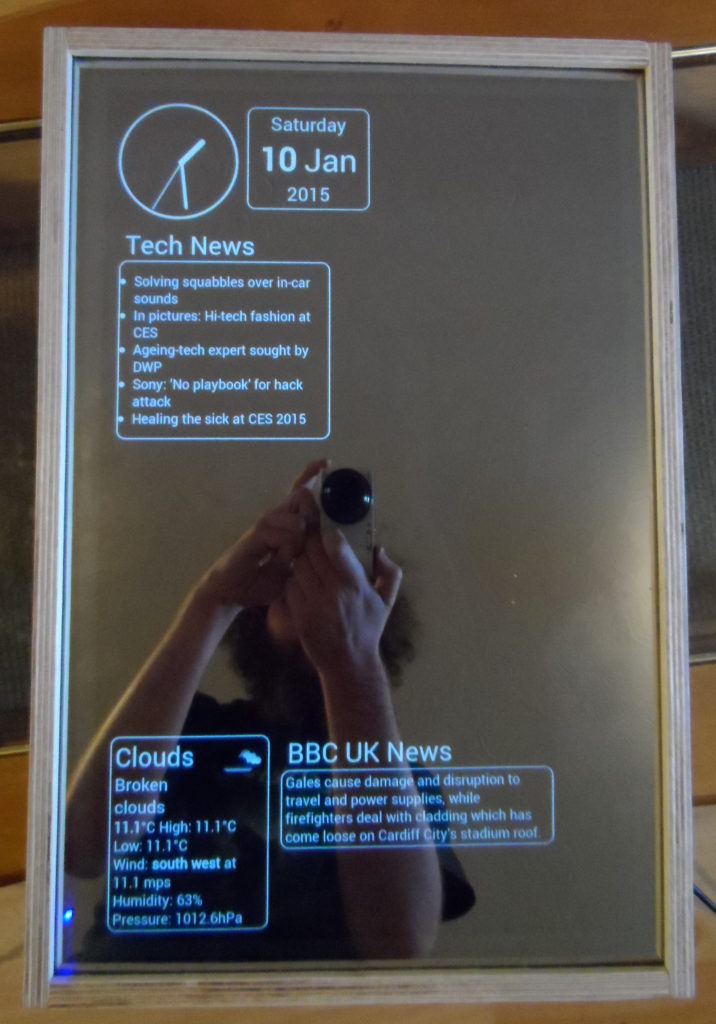

- #Raspberry pi magic mirror component 1080p#
- #Raspberry pi magic mirror component software#
- #Raspberry pi magic mirror component tv#

I ended up using a large hole saw to cut slightly more than half a circle out of a scrap piece of wood. I also wanted a place to mount a passive infrared (PIR) sensor to the mirror so that I could program some screen wake/sleep behavior.
#Raspberry pi magic mirror component tv#
The mirror glass will ultimately be sandwiched between the front facade and the TV chassis. I found some extra trim pieces in the basement (left by the previous home owner) and glued them to the box frame with some strong wood glue to create a front facade. It was a good excuse to get my dad’s old drill press back in working order. I then measured and drilled many, many holes for the speakers (left/right), power cable (bottom), ventilation (top), and buttons (lower right). I used 4" x ½" inch boards to build a box frame around the TV chassis and secured them with corner brackets. The speakers and power/volume button assemblies were mounted to the outer housing, but I wanted to retain their functionality, so I attached them to the inner chassis with double-sided tape. Like most TVs, the display, power supply, and motherboard are all mounted together on a single chassis, so it was easy to work with. I first removed the outer plastic housing. For those of you who attended Beerfest 2019, this is the TV that was mounted to the deck and was ultimately rained on that day…. Any smaller and it wouldn’t be very useful as a mirror and any bigger and I would have broke the bank buying the mirror glass (more on this later). It’s a 42 inch TV and was just the right size for this project.
#Raspberry pi magic mirror component 1080p#
The fact that it had Wi-Fi and an HDMI output made it a good fit for the job.įor the display I used an absolutely ancient 1080p LG LCD TV from like 2009 that my wife had in her apartment before she even met me. I had an old Raspberry Pi 3B laying around collecting dust so I decided that it would be the brains of my Magic Mirror.
#Raspberry pi magic mirror component software#
Check out my next post for details regarding the software configuration. The image below depicts the final layout of my mirror. The MagicMirror project is modular and there are many third-party modules available. What content or information you display on the mirror is completely up to you. A computer-connected display sits behind a piece of two-way glass-the same stuff you see in interrogation rooms in crime movies and TV shows-which gives the illusion of text floating within a mirror.

What is a Magic Mirror?Ī Magic Mirror is a smart mirror running open source software from the MagicMirror project. I am pretty happy with how my mirror frame and mounting turn out so I figured I would share that story here. But most of the articles I could find had to do with the software side of the project and I couldn’t find many ideas regarding hardware beyond “use a Raspberry Pi”. I had seen pictures of these smart mirrors online for years and always thought they were a great idea. Last winter I took on the task of building a Magic Mirror and I am finally getting around to posting about it now. The winter months are normally when I start new tech projects since Vermont winters tend to keep me indoors. My Magic Mirror adventure is split into two parts, this post will cover the hardware and my next post will cover the software side of the project.


 0 kommentar(er)
0 kommentar(er)
